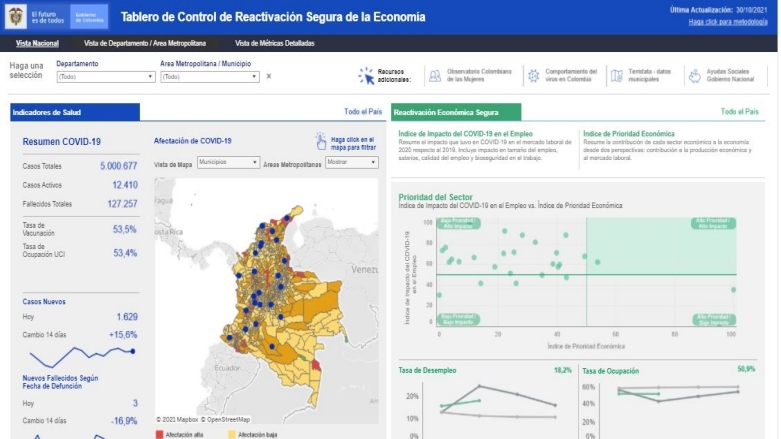Challenge
At the onset of the COVID-19 pandemic, the government of Colombia looked for strategies both to manage the health impacts of the coronavirus and to minimize the impact of the protective lockdown on employment and productivity. Weeks of shelter-in-place orders had helped contain the spread of the virus, but the lockdown had also negatively impacted peoples’ lives and livelihoods. The government wanted to be able to determine when and how to safely reopen the economy. A major challenge was to integrate the more than two dozen relevant but fragmented datasets so that health and economic data could be brought together in a single dashboard built to meet local policy makers’ information needs.
Approach
Through the analytical work Better Knowledge and Analytics to Support Governments' Response to COVID-19 in LAC, the World Bank responded to Colombia’s need for an integrated data solution to meet the crisis. The Bank brought together the expertise of its Health and Social Protection and Jobs Global Practices staffs to design Colombia’s COVID-19 Safe Economic Reactivation Dashboard, a tool aimed at helping decision-makers in two areas:
1. Real-time monitoring of the pandemic’s impacts on key epidemiologic indicators relating to the spread and health burden of the virus and the capacity of the public health and health care sectors to respond; and
2. In-depth analysis of the preparedness of the economic sectors to achieve a safe economic reactivation.
The team designed the COVID-19 Safe Economic Reactivation Dashboard to provide analysis that combines the importance of each sector for both national GDP and local employment with its capacity to restart productive activities without generating more pressure on the health system. Almost all Dashboard indicators are disaggregated by gender and by ethnicity, raising awareness about the disproportionate impact of the pandemic on women and on different ethnic groups.
Results
The Dashboard helps mayors and governors determine the safest economic sectors to reopen and to understand the impact of their decisions on jobs and the economy. As of August 2021, it had been used by more than 20,000 unique visitors, and training had been provided to more than 400 mayors, governors, and national policy makers.
The Dashboard represents a timely, cross-sectoral strategy for supporting governments during the COVID-19 pandemic. The project, responding to the immediate development challenge faced by the government of Colombia, helped convene public agencies toward the common objective of an integrated economic reactivation dashboard. The Dashboard was endorsed by the Presidency of the Republic and has become a key resource for decision-making in a context of high uncertainty and imperfect information.
This activity brought to bear the expertise of both the Bank and leading global academics, first to produce a working prototype and then to automate its production, allowing information to be updated daily with information from more than a dozen datasets. After the desktop version was established, the Dashboard was then redeveloped for mobile use.
This work has shown the possibilities for data integration between the health and labor ministries and other government agencies, thus strengthening government capacity. The tool was shown on national television by the President of the Republic of Colombia in July 2020. The president called for dissemination events with mayors and governors and participated with the vice-president in events to raise awareness about the importance of using real-time data to manage crisis response.
Bank Group Contribution
The Bank, through the Bank Budget, provided a total of US$100,000 in initial funding for this work and for its later expansion. This contribution was supplemented by additional funding of US$50,000 from the Korea-World Bank Partnership Facility (KWPF). The KWPF’s overall objective is to assist developing World Bank member countries in achieving inclusive and sustainable economic growth and to foster broader dialogue on economic development issues.
Partners
The Korea World Bank Group Partnership Trust Fund provided financial support for this work during 2020 and 2021. In addition, the initiative benefited from the expertise of academic partners at the Dalla Lana School of Public Health at the University of Toronto and of Deloitte Canada’s artificial intelligence and data visualization practice.
Beneficiaries
The Dashboard benefits Colombia’s 1,100 mayors and their support teams daily in making decisions related to managing the health and economic impacts of the pandemic. The Dashboard has accommodated more than 20,000 users thus far, and its new, mobile-friendly version increasingly meets the needs of the general public, health care providers, and insurance companies by providing easy access to localized data on key public health and health care indicators related to the COVID-19 pandemic.
Moving Forward
As the COVID-19 pandemic continues, and in anticipation of a possible fourth wave in late 2021, the Dashboard remains of great use to policy makers. The government and the World Bank have developed a communications and social media strategy to disseminate knowledge of the instrument among policy makers and the general public. The Dashboard is automatically updated daily, encouraging its use, and it is now available on smartphones. The World Bank continues to engage with the government of Colombia and with Colombia’s mayors and governors to improve the Dashboard’s functionality.
Other countries have embraced this approach. The Ministry of Finance of Peru asked the World Bank to develop a similar dashboard adapted to the Peruvian context, and the Peru Dashboard for Safe Economic Reactivation was released in June 2021.
Learn more
Coronavirus Colombia dashboard
When and how to safely reopen the economy
Better data safe economic reactivation
A vaccine for economic reactivation
